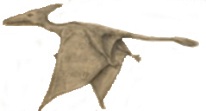The dominance of long tails and head crests has caused skeptics to insinuate that hoaxers are creating a hodge-podge of pterosaur characteristics, taking attributes from different types of pterosaurs and constructing a hoax thereby. Those skeptics, however, fail to carefully examine the hoax hypothesis, for there are numerous problems with the idea that hoaxes played a significant role in the overall eyewitness testimonies.
At least one species of Rhamphorhynchoid (long-tailed pterosaur) known from fossils, the Scaphognathus crassirostris, did have a head crest. The presence of a head crest on a ropen (or modern long-tailed pterosaur) is hardly a sign of a hoax; how many potential hoaxers would know about that fossil? (And how many natives on remote tropical islands would know about any fossils?) Westerners who might consider a pterosaur hoax would most likely use what is well-known in Western culture: stubby-tailed pterosaurs, like those depicted often in movie and television sci-fi. Potential native hoaxers would talk about flying humans that transform themselves into snakes; honest native eyewitnesses talk about a long-tailed feather-less creature, and only some native eyewitnesses have had a good-enough viewing angle to allow them to see the head crest (Gideon Koro, of Umboi Island, was honest enough to admit that he did not have a good view of the head of the giant ropen that flew over Lake Pung around 1994).
The consistency, in eyewitness descriptions from around the world, of the combination of a long tail and a head crest (in a feather-less flying creature) is evidence for a living creature, not a hoax. And why should a modern pterosaur be very much like most pterosaur fossils? Ridicule from skeptics comes from our adopting the obvious interpretation of those eyewitness descriptions: a modern living pterosaur. “Unlike pterosaur fossils” is not just inaccurate: It is irrelevant.
 Apparent Rhamphorhynchoid pterosaurs were observed in Cuba, in the mid-20th century
Apparent Rhamphorhynchoid pterosaurs were observed in Cuba, in the mid-20th century




I noticed one exception related to the head crest and long tail. Duane Hodgkinson (World War II veteran who reported a “pterodactyl” just west of Finschhafen, New Guinea) reported both a head crest and a long tail. The creature reminded him of the “pterodactyl” in the old “Ally Oop” newspaper cartoon strip (it sometimes showed a creature with both head crest and long tail). A person who did not know much about Hodgkinson’s testimony might consider that the old veteran was unduly influenced by the cartoon image.
Hodgkinson, however, was not shocked by what he at first thought was a “pterodactyl,” visualizing features that his mind inserted onto the experience. When the creature first took off into the air, he assumed that it must have been a bird; only after looking at it, taking in the features of it, did he realize the differences: long tail and long head crest.
But few, if any, other eyewitnesses of apparent pterosaurs were likely to have been influenced by that old cartoon strip, for that cartoon went extinct decades ago. Most recent depictions of pterosaurs (movies and television especially) are of Pterodactyloids (short tail).